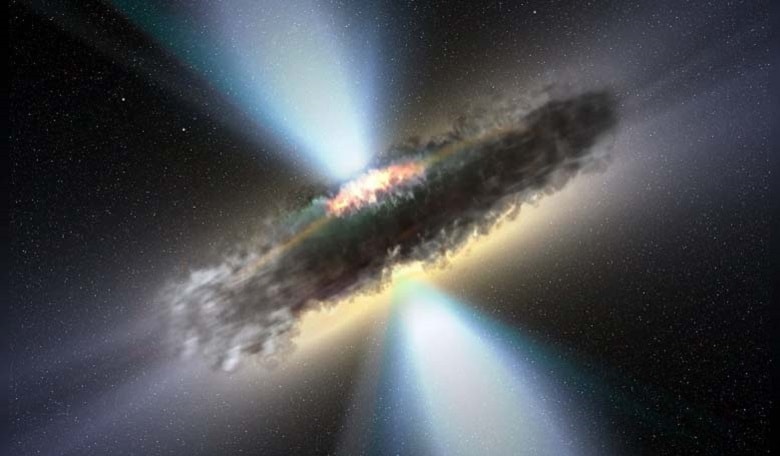The discovery of very bright quasars, (with luminosities ≥1047 ergs−1, at z ≃ 6*1) in the Sloan Digital Sky Survey (SDSS) suggests that some supermassive black holes (SMBHs) as massive as a few times 109 solar masses already existed when the Universe was less than 1 Gyr old. Explaining how how these SMBHs became so massive within 1 Gyr however has presented astronomers with a number of challenges.
It is known that black holes are formed when a massive star explodes, therefore the most obvious way to make primordial SMBH seeds is from the collapse of the hypothesised very first stars - Population III stars – in the early Universe (see https://room.eu.com/news/Using_gravitational_waves...). By a combination of either mergers or through accretion of gas onto the newly formed primordial stellar black hole, these processes offer a natural way in which to grow black holes to their much larger cousins, SMBHs. However, this scenario has been challenged as both the radiation from the Pop III progenitor star and the radiation emitted in the accretion process itself, result in feedback which might slow down gas accretion.
It has hence been suggested that the seeds of SMBHs are formed via a process known as directcollapse black holes (DCBHs), whereby a gas cloud composed of atomic hydrogen collapses isothermally. This method also has its problems, as the likely outcome of such a process would result in fragmentation of the gas allowing it to cool and form stars. Past studies have shown however, that this can be overcome and while the gas collapses, Lyman-alpha photons (light emitted from one-electron ions – generally hydrogen atoms) can get trapped in highly dense regions owing to the large optical depth of the medium. The time required for the Lyman-alpha photons to escape the medium becomes larger than the free fall time of the gas which prevents the gas from cooling and forming Pop III stars. Accordingly, the collapse can result in a massive direct-collapse black hole with an initial mass of around 104.5−5.5 solar masses, eventually growing up to 106−7 solar masses by accretion of the halo leftover gas, thus providing the seeds for a SMBH.
At redshifts greater than 6 (z > 6.5), the Lyman-alpha (Lyα) line is virtually the only line available to confirm sources with current instruments. However, Lyα is easily attenuated by dust and neutral hydrogen in the inter-stellar and inter-galactic medium. Nonetheless, objects known as Lyα emitters (LAE) have been observed by astronomers at these redshifts, the brightest of which is known as CR7. Through spectroscopic studies of CR7, it was initially thought that this object might host a Pop III-like stellar population, it is now suggested though that this object could instead be powered by accretion onto a direct collapse black hole (DCBH).
In order to try and determine the origins of objects such as these and to thus test and refine models of galaxy formation and evolution in the early Universe, lead author Fabio Pacucci of Scuola Normale Superiore, Italy, has published research along with an an international team of astronomers, presenting a method in which to identify DCBH candidates in deep multi-wavelength surveys (CANDELS/GOODS-S*2) via infrared light. The team suggest that such objects are characterised by a steep spectrum in the infrared (1.6 − 4.5 μm), i.e. by very red colours and when coupled with a corresponding X-Ray detection, their method has identified two DCBH candidates, object 29323 and object 33160.
The team state that “These objects represent the most stringent observational identification of black hole seed candidates, likely formed as DCBHs, so far obtained. The possible presence of markers of DCBH activity, such as the predicted He II emission line, needs to be investigated with spectroscopic follow-up observations.”
However, Pacucci et al recognise that a spectroscopic analysis of these sources is beyond the capabilities of current observatories (e.g. HST, VLT, Keck) because they are too faint. This limitation will hopefully be bypassed when the James Webb Space telescope (JWST) is deployed in October 2018. As the mission gets underway, a large wealth of infrared spectroscopic data (extended above the ∼ 2.5μm limit of ground telescopes) is expected, which will disclose the first glimpses of light in the Universe, and will also hopefully confirm the origins of objects 29323 and 33160.
Further information on this research can be found at http://arxiv.org/pdf/1603.08522.pdf
[Additional notes: *1; Redshift, z, represents the scale factor of the universe at the time that the light we see was originally emitted, compared to the size of the universe today. Redshifting of light increases with distance, so the higher the redshift, the further back in time we are seeing. For a redshift of 6 that roughly corresponds to an age of the Universe of 0.942 Gyr.
*2; The Cosmic Assembly Near-IR Deep Extragalactic Legacy Survey (CANDELS) is a powerful imaging survey of the distant Universe being carried out with two cameras on board the Hubble Space Telescope. It is designed to focus on two critical epochs in cosmic evolution, “Cosmic Dawn", less than 1 billion years after the Big Bang and "Cosmic High Noon", 2-4 billion years after the Big Bang. In the first epoch the first seeds of cosmic structure began to take shape, while in the second, galaxies went on a growth splurge as huge gravity-driven rivers of gas flowed into them along the "cosmic web.” For more information on this survey, go to http://candels.ucolick.org/About.html]











